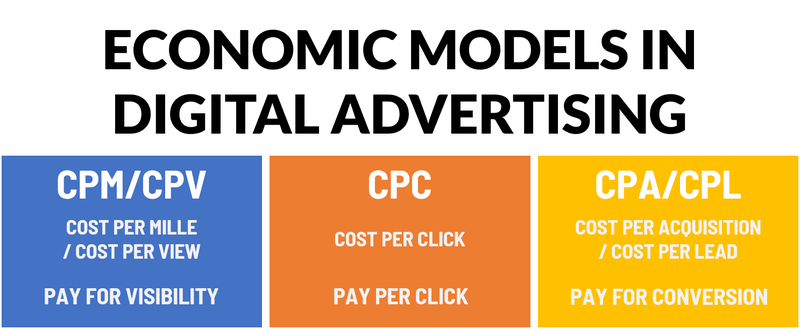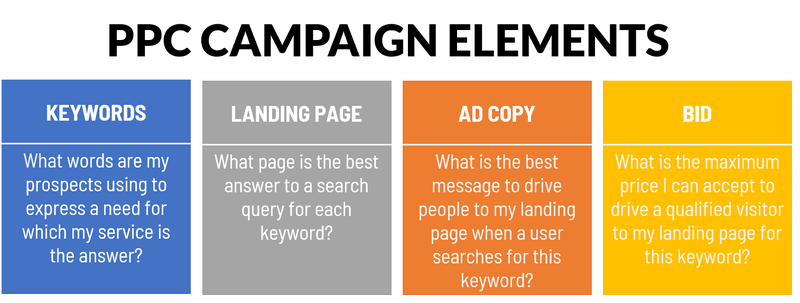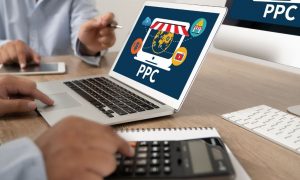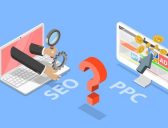The basic beliefs of advertising were shaken up in 1996 with the arrival of the GoTo.com search engine, created by Bill Gross of Idealab. Before that date, people were inclined to cite David Ogilvy: “Half the money I spend on advertising is wasted, and the trouble is I don’t know which half.” David Ogilvy, 1963.
The GoTo search engine provided sponsored results when a user entered a keyword, and the advertiser only paid when a user clicked on one. Half of your advertising money wasn’t wasted anymore.

Overview: What is PPC?
The economic model Bill Gross established for search engine marketing is called pay per click (PPC), and its measurement unit is the cost per click (CPC). If you were looking for the People’s Party of Canada, you have come to the wrong article. PPC has its biggest application in search marketing today.
To many people, PPC is synonymous with paid search, and for many years it was a synonym for AdWords, the original name of Google Ads, the largest provider of paid search advertising.
However, PPC is widely used across digital advertising today. It is the primary advertising model for all the search engines and shopping engines, and it is sometimes an optional payment model in social media advertising, affiliate marketing, and programmatic display advertising. If you launch an advertising campaign on Quora Ads or Reddit, you will find the PPC model to be an efficient strategy there.
5 benefits of using PPC ads to market your small business
PPC is blurring the lines between marketing and advertising. It is actionable and it is leads- and sales-oriented like marketing, but it is also paid visibility — just like other advertising. As a small business, you have surely explored all the possibilities you can think of for generating visibility and leads organically via networking and content.
Once you have moved past the things you can do with SEO, community management, and free advertising, the logical next step is to leverage that work with a PPC campaign. Let’s look at some of the benefits.
1. Accelerate your marketing
It is a common understanding that SEO is one of the best ways to generate visibility and traffic to your website, but is also commonly accepted that it takes time. The same goes for building up following and traction on social media. And “Oh my, that number of email subscribers to my newsletter is growing slowly all by itself.”
Now to accelerate your market presence, your business can do advertising. This doesn’t mean outsourcing marketing, especially in early stages, as you can start doing PPC ads by yourself right away.
2. You pay only when users click
When you imagine doing advertising, perhaps what springs to mind is a big billboard with your company logo on it, or a TV ad where you present your product. Those types of advertisements are about reaching as large a relevant audience as possible with a standard message. They belong in the world of the CPM economic model: a cost per thousand impressions.
As opposed to the economic models where you pay for visibility, in PPC advertising you get that visibility for free and pay only when a user clicks on your ad. This doesn’t work on the billboard, of course.
3. PPC is action-driven rather than visibility-driven
So billboards are not the right place to do PPC, but you are not looking for mere visibility either. PPC is used on actionable ads that you find online, like in search engine results, where you are looking for actions, rather than visibility. This corresponds to a different stage in the marketing funnel.
We are not at the top of the funnel, where users are first becoming aware of a need. We are at the consideration stage, where users are actively looking for a product or a service, to compare offerings and understand the market, and to identify suppliers they may buy from.
4. You can measure results
All digital advertising is measurable. You measure impressions and views, you measure click-throughs, and if you have set up campaign tracking on your website, you can create an entirely measurable lead generation funnel, making your marketing outcomes predictable, and allowing you to control the number of sales leads you generate for a certain budget.
5. You can stop anytime
The first version of Google AdWords marketed itself saying that all you needed was five minutes and a credit card to get started. If you want your campaign to be effective, of course, you should spend a little more time on getting it right. What is certain is that you can stop a campaign in less than 5 minutes.
With PPC, you don’t have to deal with monthly budgets or guaranteed payments. You pay as you go, and you stop whenever you want, with the click of a button.
How to develop and manage your PPC campaign
Five minutes and a credit card. This is still the mission of most PPC advertising campaigns in the market. Have your credit card, the URL of your website, your company details ready, and start the timer.

1. Account setup
Setting up an ad account is really fast and easy. In many cases, you will already have an account with the search engine or social network you want to do PPC advertising on. By going to the advertising section or trying something like ads.nameofsearchengine.com or socialnetwork.com/ads, you will find the ad consoles.
Via your personal account, you can then set up a company profile by adding the company name and billing information. This is where you need the credit card, but you can actually wait until launch for this.
Once your account is set up, there are two important steps we recommend. They don’t fit into your “five minutes” launch and you may not need them right away, but doing them now will help you get the best out of your advertising campaigns:Conversion tracking:
Audiences:
If you choose to move along without diving into these subjects now, remember to come back to them quickly, as they will drive better performance for your campaigns. For now, create a campaign and set a budget for it.
2. Keyword and topical research
Keyword and topical research are not optional, but in your “five minutes” you will not be able to do an in-depth piece of keyword research. No problem, you can start with a limited scope now and revisit it later. You’ll want to do that because it is essential that your ads are seen in the right context, and by the right people.
But to just get started, you can use a free keyword tool to find some of your initial keywords, and launch your campaign on that basis. The keywords you should select correspond to this question: “What words are my prospects using to express a need for which my service is the answer?”
3. Landing pages
Your home page was built so that users who do not know your business can easily get an understanding of who you are, what you do, and where they can find more information or engage with you. For a search campaign, that is not the right place to send traffic. A landing page is the page to which you send traffic from your PPC campaign.
It may be a good idea to build specific landing pages for your campaigns to optimize the user experience, but you may also already have pages on your website that can be a good match. Ask yourself the following question for each of your keywords: “Which page is the best answer to a search query for this keyword?”
4. Ad copy
The third element in your search campaign is the ad copy. It can be one set of ads for all your keywords or one per keyword. The right mix is somewhere between and depends on the similarity of the keywords you have chosen.
Again, ask yourself the question for each keyword or group of keywords: “What is the best message to drive people to my landing page when a user searches for this keyword?” Best practice is to write four ad variations for each ad set.
5. Bids
The final element in your search campaign will feel like the most challenging one because it is more difficult to relate to: You need to set your bids. PPC advertising has evolved a lot since the initial version on GoTo.com where the bids were based on an incremental auction. The more you were willing to pay, the higher up in the search results you would appear.
Google brought a major innovation to its advertising engine, something called quality score. Most advertising engines today have something similar. It scores each ad on the basis of its match with the search keyword.
The better the fit, the higher the quality score and the lower the bid needed for your ad to be a result on that keyword. The advertising engine will often recommend a maximum CPC for your campaign or keyword. You can use a lower bid than the recommended bid, of course. A max CPC means only that this is the maximum price you will pay for a click.
The real campaign cost depends on competitors, quality score, and user demand. Set bids as a cap by asking yourself this question: “What is the maximum price I can accept to drive a qualified visitor to my landing page for this keyword?
6. Campaign launch
You are ready to launch. If you didn’t enter your credit card details in step one, this is the time to do it. Take a deep breath — your five minutes are nearly up — then launch your campaign. Campaigns typically don’t go live immediately.
Depending on ad copy, business sector, and keywords, there can be verifications that need to be cleared before your campaign is active. Perhaps you can use that time to revisit some of the things you did too superficially.
7. Monitoring and optimization
You typically wait for a day before you look at your reporting. This is enough time for the campaign to start and to collect sufficient data to actually see what is happening. The results are probably not what you dreamed of. But the good news is that you can improve them on an ongoing basis. One of the first things to work on is to add negative keywords to remove irrelevant clicks.
After reviewing your keywords to see how well they match your ads, perhaps you can try some more ad variations to see how they perform. Take one of the keywords that are driving traffic to your site, then put yourself in the user’s skin.
Type the keyword, look at the ad, visit your website. Take note of all the things you could improve in that user journey. This is also a good time to think about audiences, conversion tracking, and customized landing pages.
You are up – but are you running?
PPC advertising is very different from classic advertising. You could never launch an advertising campaign in such a short time, and you couldn’t adjust it once it was launched. You therefore had to spend a lot of time defining your strategy and your message before launch.
You still need the right strategy and messaging in a PPC campaign, but you can test and learn, and get those things right after you launched the campaign. In classic advertising, your job would be over once the campaign launched, but in PPC advertising, it has only just started.
The post A Guide to PPC (Pay-Per-Click): How to Set Up Your First Campaign appeared first on The blueprint and is written by Anders Hjorth
Original source: The blueprint



